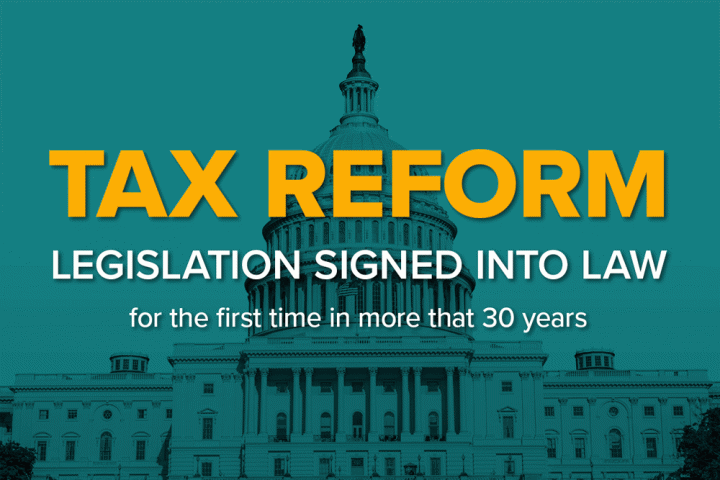Economic Impact of the New 2017 Tax Law
May 16, 2018

The new tax reform act (H.R. 1) (the “Act”), signed into law by President Trump on December 22, 2017, reduces marginal tax rates and makes other policy improvements. This has a positive impact on the U.S. economy. Economists estimate the new law will probably increase GDP in the long-run by about 2% points. Thus, with a GDP of 0.9% at the time the law was written, the expected GDP will be 3.1%. Most of this gain is likely to occur in the first five or six years.
Impact on Businesses
The most important pro-growth aspect of the legislation is the permanent reduction in the U.S. corporate tax rate to 21% starting in 2018. This will increase investment and productivity. It will make the U.S. a more attractive place to invest. The corporate alternative minimum tax (AMT) is also repealed.
Under U.S. law, pass-through entities (e.g. sole proprietorships, partnerships, limited liability companies, and S corporations) do not pay income taxes at the entity level. Instead, the owners of the pass-through entity pay income taxes on the funds allocated to them personally on their personal income taxes. The new legislation reduces the tax rate for many pass-through businesses by introducing for the first time a lower tax rate for certain pass-through businesses. These new rules, more applicable to smaller businesses, are complex.
The Act added a new provision to the tax code (i.e., IRC Section 199A), for taxable years beginning after 2017 and before January 1, 2026, which allows taxpayers other than corporations to deduct 20% of their allocable share of qualified business income from pass-through entities, subject to certain limitations and exceptions. Qualified business income generally includes net income effectively connected with a U.S. trade or business from any qualified trade or business, but does not include any reasonable compensation paid to the taxpayer or any guaranteed payment paid to a partner for services rendered with respect to the trade or business, nor does it include any capital gains or losses, dividends, or interest income other than interest income which is properly allocable to a trade or business.
Under the new Code Section 199A, income generated by a pass-through entity may qualify for a 20% deduction with a phase out threshold of $157,500 for single filers or $315,000 for married filing jointly taxpayers for income from a specified service business (“SSB”). SSBs include businesses where the principal asset is the reputation or skill of one or more of its employees or owners (such as in the field of health, law, accounting, consulting, athletics, financial services, brokerage services, etc.), except for engineering and architectures services where were specifically exempted. For non-SSB income the deduction is not necessarily phased out but the limitation rules will apply, i.e. the 20% deduction cannot exceed the greater of (a) 50% of W-2 wages with respect to the business or (b) the sum of 25% of W-2 wages plus 2.5% of the unadjusted basis, immediately after acquisition of depreciable property).
The cost of most equipment purchased by businesses will be expensed (i.e. immediately deducted rather than depreciated) for five years. This bonus depreciation is available for purchases of both new and used property. Beginning in 2023, these rules phase-out and by 2027 normal cost recovery rules will apply. The legislation also increases the Section 179 threshold to $1 million, so small businesses will be able to deduct the cost of equipment purchases.
In general, the deduction for business interest expense may not exceed the sum of business interest income plus 30% of adjusted taxable income. Adjusted taxable income is determined without regard to depreciation, amortization, or depletion for the first five years. This limitation applies to both C corporations and pass-through entities.
Impact of International Tax Changes
The tax bill moves the U.S. tax system substantially from a system of worldwide taxation towards a territorial system. As a transition to the new system, the Act imposes a mandatory tax on post-1986 accumulated foreign earnings and profits. Foreign earnings held in cash or cash equivalents are taxes one time at a 15.5%, and accumulated foreign earnings held in illiquid assets are taxed at 8%. This tax is mandatory, regardless of whether cash or other property is distributed to a U.S. parent entity. Taxpayers have the option to pay this tax over an eight-year period.
Once this tax is paid on foreign earnings and profits, companies will be allowed to take a 100% tax deduction for the foreign source portion of dividends received, meaning they will be able to distribute cash back to the U.S. essentially tax free.
Conclusion
The new legislation lowers marginal tax rates for businesses, allows the expensing for equipment and improves international tax. These factors have a positive impact on the U.S. economy. Investments will increase and productivity will improve. Economists expect the economy to grow by about 2% points over a period of five or six years.
Endnotes
Source: “Economic Impact of U.S. Tax Reform” by David R. Burton, February 1, 2018.











